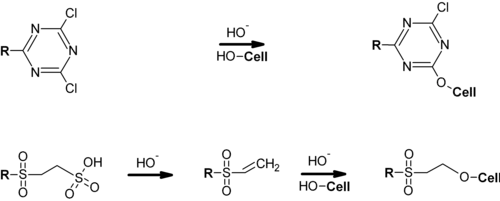Reactive dye
In a reactive dye, a chromophore (an atom or group whose presence is responsible for the colour of a compound) contains a substituent that reacts with the substrate. Reactive dyes have good fastness properties owing to the covalent bonding that occurs during dyeing. Reactive dyeing is the most important method for coloring cellulose fibers. Reactive dyes can also be applied on wool and nylon; in the latter case they are applied under weakly acidic conditions. Reactive dyes have a low utilization degree compared to other types of dyestuff, since the functional group also bonds to water, creating hydrolysis.[1]
Usage
Reactive dyes had been tested in the late 1800s involving both adding functionalized dyes to the substrate and then activating the substrate first followed by fixation of the dye. The first commercial success was described in the early 1950s. Rattee and Stephens at Imperial Chemical Industries (ICI) popularized the chlorotriazines as linkers between the substrate and the chromophore.
Trichlorotriazine remain a popular platform for reactive dyes. The chromophore, with an amine functional group, is attached to the triazine, displacing one chloride:
- (NCCl)3 + dye-NH2 → N3C3Cl2(NHdye) + HCl
The resulting dichlorotriazine can then be affixed to the cellulose fibre by displacement of one of the two chloride groups:
- N3C3Cl2(NHdye) + HO-cellulose → N3C3Cl(NHdye)(O-cellulose) + HCl
The fixation process is conducted in a buffered alkaline dye bath.
An alternative fixation process that is more dominant commercially is the vinylsulfonyl group. Like the chlorotriazines, this functional group adds to the hydroxyl groups of cellulose. The most popular version of this technology is Remazol. The dye is first attached to the ethylsulfonyl group.

Reactive dyes are categorized by functional group.[2]
| Functionality | Fixation | Temperature | Included in Brands |
|---|---|---|---|
| Monochlorotriazine | Haloheterocycle | 80 °C | Basilen E & P, Cibacron E, Procion H,HE |
| Monofluorochlorotriazine | Haloheterocycle | 40 °C | Cibacron F & C |
| Dichlorotriazine | Haloheterocycle | 30 °C | Basilen M, Procion MX |
| Difluorochloropyrimidine | Haloheterocycle | 40 °C | Levafix EA, Drimarene K & R |
| Dichloroquinoxaline | Haloheterocycle | 40 °C | Levafix E |
| Trichloropyrimidine | Haloheterocycle | 80-98 °C | Drimarene X & Z, Cibacron T |
| Vinyl sulfone | activated double bond | 40˚ | Remazol |
| Vinyl amide | activated double bond | 40˚ | Remazol |
Bi- and polyfunctional reactive dyes
Dyestuffs with only one functional group sometimes have a low degree of fixation. To overcome this deficiency, dyestuffs containing two (or more) different reactive groups were developed. These dyestuffs containing two groups are also known as bifunctional dyestuffs although some still refer to the original combination. Some contain two monochlorotriazines, others have a combination of the triazines and one vinyl sulfone group). Bifunctional dyes can be more tolerant to temperature deviations (better process). Other bifunctionals have been created, some with fastness (better quality) or only fixation degree (better environment or economy) in mind.[1]
See also
- Carbene dye
- Cationization of cotton for salt-free dyeing
- Dyeing
- Dispersing agent for dyeing
Footnotes
- Horst Tappe, Walter Helmling, Peter Mischke, Karl Rebsamen, Uwe Reiher, Werner Russ, Ludwig Schläfer and Petra Vermehren "Reactive Dyes"in Ullmann's Encyclopedia of Industrial Chemistry 2000, Wiley-VCH, Weinheim. doi:10.1002/14356007.a22_651
- Stig Hjortshøj (1999), pp. 44–45.
External links
For more info Fundamental Chemistry of reactive dyes Advancements in Reactive Textile Dyes
